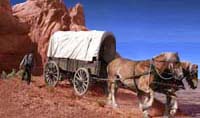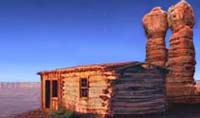Silas Sanford Smith Jr.
Born: October 26, 1830, in Stockhom, St. Lawrence County, New York
Died: October 11, 1910, in Layton, Utah
Married: Clarinda Ricks, (July 9, 1851)
Married: Sarah Ann Ricks, (March 17, 1853)
Married: Martha Eliza Bennett, (July 19, 1865)
Father: Silas Smith
Mother: Mary Aikens
Childhood
Silas Sanford Smith was born October 26, 1830 in St. Lawrence County, New York. His father, Silas Smith, was an uncle to the Prophet Joseph Smith (being a younger brother to Joseph Smith, Sr.). He was baptized into the LDS Church in 1835 by his nephew, Hyrum, and remained faithful to it until his death. For the next twelve years, the Silas Smith family moved many times as a result of the persecutions suffered by the early Church. First was a move to Kirtland, Ohio, and two years later, a move to Missouri, from which they were driven by mobs in 1839. Silas Smith (Sr.) died at this time due to illness incurred during the family’s flight from Missouri. i Silas Sanford was nine-years-old at the time. He, his mother, and younger brother Jesse Nathaniel, eventually settled in Nauvoo, and were there at the time of the Prophet Joseph Smith’s martyrdom. In 1847 they crossed the plains in the Perregrine Sessions’ company and arrived in the Salt Lake Valley in late September, 1847, a month before Silas Sanfords’ seventeenth birthday.
Marriage, Military, and Missionary Work
In 1848, Silas Sanford built a home on North Temple, but did not stay there long. The next year he built another home near Farmington, in Davis County, where he raised crops during the years of 1850-51. In July 1851, he married Clarinda Ricks, and a few months later was called by the Church to settled in Parowan, to which the young couple embarked willingly that fall. Together, Silas and Clarinda became the parents of five children.ii
In 1853, Silas Sanford Smith married a second wife, Sarah Ann Ricks, sister to Clarinda, with whom he had four children. At the time of this second marriage, Silas Sanford was serving in the military fighting in the Indian War of 1853. The next year, however, he was called on a mission to the Sandwich Islands (Hawaii). In order to afford the passage fare to the Islands, Silas worked for three months in San Francisco before departing. As a missionary he likewise worked hard and dedicated himself to learning the native language and preaching the gospel. He even served as a counselor in the mission presidency for a time before he returned home in 1856.
A Military and Civic Leader
Upon his return, Silas Sanford moved his family to Paragoonah, in Iron County, and became active again in military service. He gained the rank of major and was in charge of organizing and training local residents to defend their settlements. He learned to speak several Indian languages, and gained a reputation for being a fair-minded diplomat. Silas Sanford participated in the Black Hawk Indian War of 1860-1865, and was considered a wise military leader. In 1866, he led a group of seventy-six to establish a defensive fort – named Fort Sanford – in the area of Panguitch.iii
In 1859, at age twenty-eight, Silas Sanford Smith was elected to the Utah Territorial Legislature as a representative. He served in this capacity for almost twenty consecutive years, during which time he also held the offices of U.S. Deputy Marshal, selectman, and probate judge.iv In addition to these civic responsibilities, Silas Sanford served as a bishop in Paragoonah for several years.
Both of his wives – Clarinda and Sarah Ann – passed away within three months of each other, leaving Silas Sanford a widower with nine children. So in 1864 he married Martha Eliza Bennet – known as Eliza – who proved herself a capable step-mother to nine, and eventual mother of twelve children of her own.
President of the San Juan Mission
In 1879, Silas Sanford Smith was called to preside over the San Juan Mission in San Juan County, Utah. He had been praised by Elder Erastus Snow, one of the Twelve Apostles of the L.D.S. Church, in a letter to Church President John Taylor, as someone who would “make a discreet presiding officer to lead settlements on the San Juan.”v Likewise, Kumen Jones, a member of the Hole-in-the-Rock Expedition, wrote in later years of Silas S. Smith as a “prudent, wise, resourceful man, particularly well equipped by nature and experience for a leader in that undertaking.” Jones noted that Smith’s familiarity with Indian languages and peoples, experience in civic legislation, and understanding of L.D.S. Church organization and history made him “the right man for that difficult work.” vi
Under Smith’s leadership, an exploring party set out on April 14, 1879 to select a site suitable for settlement along the San Juan River. The group consisted of twenty-six men, two women, and eight children. They traveled almost 300 miles southward on rough but existing roads until reaching the settlement of Moenkopi, in present-day Arizona, where they rested for a week and prepared to travel in a north-easterly direction toward the San Juan River. This leg of their journey was much more difficult and dangerous due to rugged terrain, which lacked a good road, the deficiency of water in the region, and the presence of hostile and troublesome Indian tribes. Yet in spite of these trials, on June 2, 1879, the exploring party set up camp at Montezuma, and spent the next few months preparing the area for settlement. In August, most of the exploring party departed, under Smith’s leadership, and returned to Paragonah via the Old Spanish Trail, completing what had become near to a thousand-mile journey. However, they did not waste time getting organized for a return trip to the San Juan, as it was hoped the area could be reached again before winter set in.
The responsibility of how best to move the main body of settlers to Montezuma fell upon President Smith. His experience with the exploring party had created doubt as to the best route to take. The southern route through Moenkopi was dangerously dry, difficult, and filled with Indian unrest. Yet the northern trail was considered too long, as it almost doubled the mileage required to get there. In the end, Silas Sanford made the decision to attempt a “short-cut” across the virtually unexplored region southeast of Escalante, based on reports he had received from several men who had traversed part of the territory in question. It was this decision that eventually led the expedition to Hole-in-the-Rock, and the arduous journey that followed it.
President Smith arrived at Forty-mile Spring, south of Escalante, on November 24, 1879, and a few days later sent a group of twelve men to discover a way to cross the Colorado River. Winter snows deterred them from considering turning back to Escalante and abandoning the promise of a “short-cut.” The scouts reported back to President Smith of the possibility of descending through the Hole-in-the-Rock to the riverbed, and then ferrying the wagons across the Colorado. David E. Miller, noted historian of the Hole-in-the-Rock expedition, writes that Smith probably did not make the decision to press on through the Hole-in-the-Rock completely on his own. Rather, given his character and the sizable consequences such a decision would have upon the whole company, President Smith likely involved the “leading men of the company” in counseling him and praying with him in order to make the best decision for the group.vii
Ironically, however, Silas Sanford Smith was absent from the expedition for most of actual trek through Hole-in-the-Rock and the unknown wilderness beyond. Shortly after the task of blasting through the stone cliffs had begun, Smith departed for Salt Lake City to procure funds and supplies. His ties the Territorial Legislature helped him secure nearly 1,000 pounds of blasting powder needed to widen and shape the Hole-in-the-Rock, along with other supplies and funds. Platte D. Lyman, who had been formerly called as his assistant in August of that year, assumed leadership of the expedition in Smith’s absence, which was prolonged due to a case of pneumonia brought on by “fatigue and exposure.”viii On April 28, 1880, however, Silas Sanford Smith began his journey back to the San Juan. He did not settle in Bluff, but continued on to Montezuma in the hopes of finding good enough land to plant corn.ix He remained president of the San Juan Mission until he was released in 1882.
President of the San Luis Stake
A year after he was released from the San Juan Mission, Silas Sanford Smith was called to preside over the San Luis Stake in Conejos, Colorado. He served in this calling until 1892. During these years, his past experience in civic affairs served him well, as he spent much time and effort aiding the saints of Conejos County to receive legal titles to their lands. The county land surveyor had removed their lands from the private settlement sphere, and returned them to the public domain as mineral lands. The ensuing land dispute between the Mormon settlers and the land office, in combination with widespread prejudice against the Saints for their practice of polygamy, created an atmosphere of tension and frustration that Silas Sanford Smith sought to dispel. x
A Life Well-Lived
In 1900, Silas Sanford Smith moved his family to Layton, Utah, where he farmed and raised livestock until his passing, on October 11, 1910. Since then, he has been lauded by many for his exemplary life. He built thirty-five homes during his eighty-year life span, fathered twenty-one children, served faithfully in civic and religious offices, and exemplified the qualities of a true leader.
Researched and written for the Hole-in-the-Rock Foundation by:
C.S. M. Jones LLC, Family Heritage Consulting.
i George A. Smith, “A Discourse by Elder George A. Smith, Joseph Smith’s Family – Details of George A. Smith’s Own Experience, Etc., Delivered in the Bowery, Great Salt Lake City, Sunday Afternoon, August 2, 1857.” Journal of Discourses, Vol. 5 available full-text at http://relarchive.byu.edu/MPNC/
ii “Silas Sanford Smith,” Pioneers and Prominent Men of Utah(Salt Lake City, Utah: Western Epics, 1966)Vol. 2, 1170.
iii Lamont Crabtree, “Silas S. Smith – Mission President and Expedition Leader,” The Incredible Mission, Crabtree, c. 1980, 157.
iv Andrew Jenson, ed., “Silas Sanford Smith,” Latter-Day Saint Biographical Encyclopedia (Salt Lake City, Utah: Western Epics, 1971),vol. 1: 802.
v Erastus Snow to John Taylor, letter dated December 29, 1878, quoted in David E. Miller, Hole in the Rock: An Epic in the Colonization of the Great American West (Salt Lake City, Utah: University of Utah Press), 13-14.
vi Kumen Jones, The Writings of Kumen Jones, (n.d.),2, 26.
viii Silas Sanford Smith, Diary, 1879-1880, 5.
|



